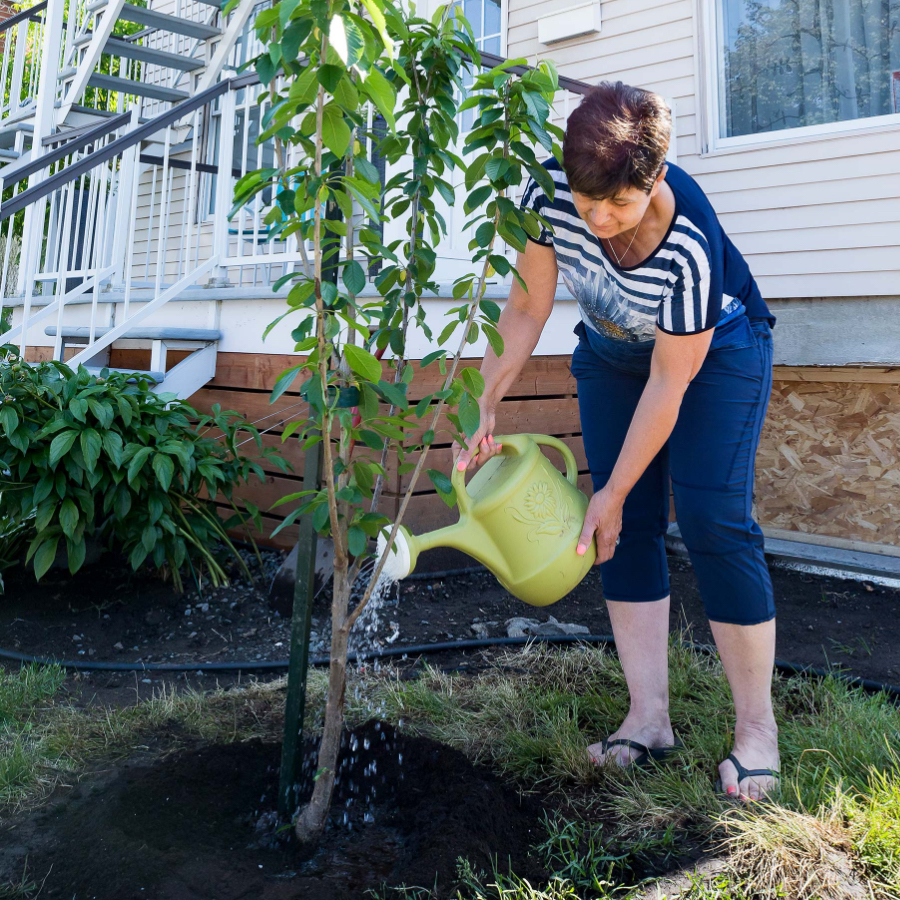Planting a tree is a wonderful gesture for the environment and for posterity.
Once established, a tree requires no special care. However, a young, newly planted tree requires some care in order to establish itself in the soil and survive the first two years of its life.


Watering
Water daily for the first 2 weeks after planting. Watering should be abundant and deep, covering the entire area under the tree canopy. If your soil does not drain well, you can water gradually to prevent runoff. Be careful not to overwater. If water pools around the tree or if the soil is extremely wet after watering, water less often.
After the first few weeks and for about 2 years, it’s better to water a large amount less frequently (every 2 or 3 days) than a small amount every day. When we talk about watering a large amount, we’re talking about several minutes of watering!
However, the frequency must be increased during dry periods. The best time to water is in the morning or evening so that the roots can absorb most of the water.
In the fall, pay special attention to conifers and evergreens that need to store water for the winter. Water regularly and abundantly before the first frost.
Support
The addition of a stake is recommended when the tree is planted in a very windy place, on steeply sloping ground, if the tree is poorly rooted or in a place with a lot of traffic.
If you are using a tutor, be sure to:
• Plant it outside the root ball;
• Install it facing the prevailing winds;
• Use a clip that does not overtighten the trunk;
• Withdraw it after 1 year.

Weeding
For small trees, weeding around the plants is essential to allow young trees to enjoy full sunlight and space to grow with ease. Also, manual weeding limits competition for soil nutrients.
Mulch
Mulch has several functions: It keeps the soil’s moisture, reduces weed growth, moderates soil temperature swings, provides nutrients and organic matter as it decomposes, protects trunks from lawn mower injury and roots when the snow cover is insufficient, shelters useful organisms and stimulates the biological life of the soil.
Choose organic mulches (fragmented ramial wood, shredded bark (such as cedar or hemlock mulch), wood chips, forest mulch, etc.).
Apply about 10 to 15 cm of mulch at the base of the tree, being careful to clear the trunk.
Fertilizer
In general, the use of planting soil (purchased at a garden centre), the addition of compost, mycorrhiza or any other amendment at the time of planting are sufficient to meet the needs of a tree. Eventually, it will find all the nutrients to grow on the existing soil. Adding fertilizer is therefore not recommended.
Pruning
In general, the trees purchased in nurseries have already been pruned to ensure that the tree will develop a single central trunk and the branches will be well arranged. If it is necessary to prune some broken or badly positioned branches, we recommend doing this before planting, since it is easier to access the top of the tree. For more complex pruning, it is advisable to hire an expert to make cuts that do not hurt the tree and that support its growth.
PROTECT FOR WINTER
To protect the roots of your tree during winter, cover the base of the tree with snow. In addition, during the first 3-5 years, it is advisable to install a rodent protector in the fall and remove it in the spring.
Watch
In order to avoid any unpleasant surprises, it is important to regularly observe your tree closely. Do you notice a colour change in the leaves? Larvae or insects? Damaged leaves? It could be a sign of diseases or greedy insects.
Do not panic! Like us, trees sometimes get sick. With proper care and treatment, your tree will quickly get better.
If in doubt, consult a garden center advisor or https://espacepourlavie.ca/carnet-horticole-et-botanique
